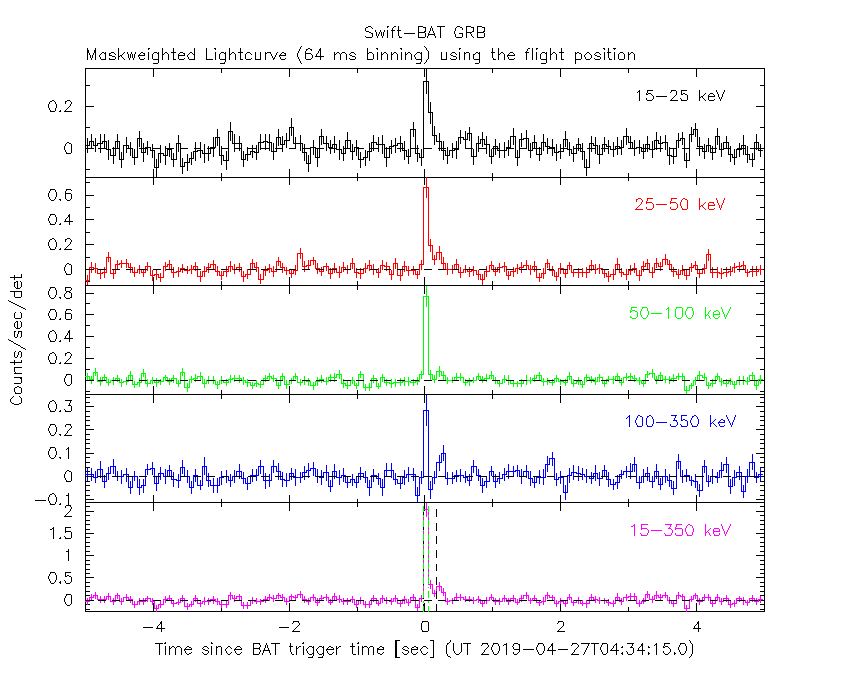
A. Tohuvavohu (PSU), S. Campana (INAF-OAB) and N.P.M. Kuin (UCL-MSSL) for the Swift team
At 04:34:15 UT, the Swift Burst Alert Telescope (BAT) triggered and located GRB 190427A (trigger=900730) (Tohuvavohu et al. GCN Circ. 24261). Swift's slew will be delayed due to an observing constraint. At the time of the trigger, the initial BAT position was 98° from the Sun (7.6 hours West) and 67° from the 48%-illuminated Moon. Table 1 contains the best reported positions from Swift.
Table 2 is a summary of GCN Circulars about this GRB from observatories other than Swift.
Standard analysis products for this burst are available at https://gcn.gsfc.nasa.gov/swift_gnd_ana.html.
As reported by Ukwatta et al. (GCN Circ. 24330),
the BAT ground-calculated position is RA, Dec = 280.217, 40.304 deg which is RA(J2000) = 1
The mask-weighted light curve (Figure 1) shows a double-peaked structure that starts from ~
The time-averaged spectrum from T-0.0 to T+0.3 s is best fit by a simple power-law model.
The power law index of the time-averaged spectrum is 1.17 ± 0.21.
The fluence in the 15-150 keV band is 1.3 ± 0.2 x 1
The results of the batgrbproduct analysis are available at https://gcn.gsfc.nasa.gov/notices_s/900730/BA/.
Analysis of the initial XRT data was reported by Campana et al. (GCN Circ. 24264).
The Swift/UVOT began settled observations of the field of GRB 190427A 3737 s after the BAT trigger
(Kuin and Tohuvavohu GCN Circ. 24333).
No optical afterglow consistent with the BAT position (Ukwatta et al., GCN Circ. 24330) is detected in the initial UVOT exposures.
Table 3 gives preliminary
magnitudes using the UVOT photometric system
(Breeveld et al. 2011, AIP Conf. Proc., 1358, 373).
No correction has been made for the expected extinction in the Milky Way
corresponding to a reddening of

Figure 1. The BAT
mask-weighted light curve in the four individual and total
energy bands. The units are counts
| RA (J2000) | Dec (J2000) | Error | Note | Reference |
|---|---|---|---|---|
| 1 |
+40°18'15.6" | 2.4' | BAT-refined | Ukwatta et al. GCN Circ. 24330 |
| Band | Authors | GCN Circ. | Subject | Observatory | Notes |
|---|---|---|---|---|---|
| Optical | Lipunov et al. | 24263 | Swift GRB190427.19 Global MASTER-Net observations report |
MASTER | |
| Optical | Izzo et al. | 24265 | NOT optical observations | NOT | |
| Optical | Hu et al. | 24272 | BOOTES-1 and BOOTES-5/JGT early follow-up observations |
BOOTES-1 | |
| Optical | Troja et al. | 24282 | RATIR Optical and NIR Observations | RATIR | |
| Optical | Watson et al. | 24287 | COATLI Optical Observations | COATLI | |
| Optical | Murata et al. | 24288 | MITSuME Akeno optical upper limits | MITSuME Akeno | upper limits |
| Optical | Zhang et al. | 24290 | Lick/Nickel telescope optical observations |
Pan-STARRS | |
| Optical | Lipunov et al. | 24294 | Fermi GRB190427.19 Global MASTER-Net observations report |
MASTER | |
| Gamma-ray | Malacaria et al. | 24293 | Fermi GBM detection | Fermi GBM | Fluence=4.855±0.717x1 (6 |
| Gamma-ray | Cannady et al. | 24339 | CALET Gamma-Ray Burst Monitor detection | CALET |
| Filter | Exp(s) | Mag | ||
|---|---|---|---|---|
| u | 3737 | 3936 | 197 | >19.9 |
Table 3. UVOT observation reported by Kuin and Tohuvavohu (GCN Circ. 24333). The start and stop time of the exposure are given in seconds since the BAT trigger. The preliminary 3-σ upper limit is given. No correction has been made for extinction in the Milky Way.
April 30, 2019